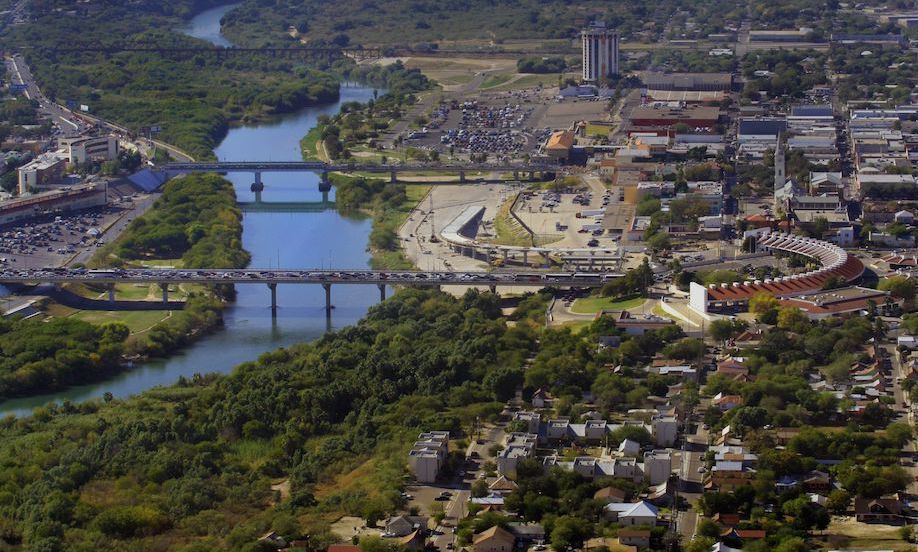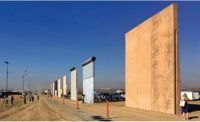Despite stiff opposition from landowners and community groups, and a U.S. Dept of Homeland Security Inspector General report that questions building a U.S.-Mexico barrier through the close border city of Laredo, Texas, the Customs and Border Protection agency has awarded a second wall construction contract there.
The city of nearly 265,000, the tenth largest in Texas, is built on the banks of the Rio Grande directly across from Nuevo Laredo, Mexico. Agency officials claimed in a recent statement it is a hot spot of illegal border crossing for drugs and undocumented persons, with most of that in areas that "lack infrastructure, access, mobility and technology."
Observers counter that Laredo has no problem with illegal activity except at four river bridges that are ports of entry and will not be blocked by the barrier. Border patrol agency (CBP) officials "plan to build a wall along the entire riverfront of Laredo including a 150-ft. security enforcement zone. It will be a profound loss,” says Tricia Cortez, executive director of the Rio Grande International Study Center.
Meanwhile, in an Aug. 7 action related to continuing controversy over administration diversion of military construction and other allocated funds for wall building, a federal appeals court in Washington, D.C. sent back for reconsideration a decision by a lower court judge appointed by President Donald Trump who ruled that the judiciary has no jurisdiction to hear the funding dispute between Congress and the executive branch.
The House of Representatives had argued that the move was a violation of its appropriation authority under the Constitution. But US district court Judge Trevor McFadden said the Constitution stipulates "independence" of the judiciary, which requires that courts “take no active resolution whatever” in political fights between the other branches.
The appeals court ruled, however, that “there is no general bar against the House of Representative’s standing in all cases” that involve disputes between the branches of government, so the lower court now must reconsider its ruing in light of that interpretation
'Public purpose'
Border property in Laredo and in most of Texas is privately owned, which requires the U.S. government to purchase parcels or to seize them through eminent domain legal proceedings for "public purpose" land survey access and construction.
This was done to a more limited extent in the Bush and Obama administrations, but such seizures have accelerated in the Trump administration, particularly in pre-election recent months, with the U.S. Justice Dept. filing more than 30 lawsuits against south Texas landowners between last December and May, including an orphanage, says the non-profit publication Texas Observer. Other legal sources point to about 75 legal actions taken against landowners since early 2019.
Data shows drugs and undocumented persons are crossing the river in private vehicles through the ports of entry, some of which have not been upgraded since the Eisenhower administration, Cortez told ENR. Current plans to construct steel and concrete barriers in a flood plain with fine river silts have engineers baffled, she said.
CBP awarded federal contractor Fisher Sand & Gravel a $289.5-million contract on Aug. 3 to build 17 miles of barrier through Laredo, which includes a bulkhead to replace the downtown riverbank.
According to Cortez, the bulkhead apparently is a seawall and has an elevated platform with metal fencing on top, although CBP has not released maps or renderings to the public.
Texas Push
CBP is propelling the wall-building effort under acting commissioner Mark Morgan, who previously headed the Immigration and Customs Enforcement (ICE) unit of DHS and is a former FBI official. The government "is actually moving faster than ever” on barrier construction, claimed the official, who has not been confirmed by the US Senate and is under fire for recent deployment of CBP agents in Portland, Ore.
The award is a task order under CBP’s indefinite-delivery, indefinite-quantity umbrella wall construction contract, with four companies selected to bid: Texas Sterling Construction, Houston; WG Yates & Sons Construction, Philadelphia, Miss.; Caddell Construction, Montgomery, Ala.; and Fisher Sand & Gravel, Dickerson, N.D.
A CBP official told ENR that the amount of the overall ID-IQ contract cannot be released, but he said its funding is under the agency’s 2020 congressional allotment of $1.3 billion for 69 miles of wall in the Laredo sector, which includes Webb and Zapata counties.
The U.S. Army Corps of Engineers also awards task orders under two ID-IQ contracts for wall construction and ancillary projects along the entire border, each valued at $5 billion. According to CBP, construction of mostly replacement barrier along 235 miles of the border was done as of mid-July.
Fisher and Caddell Construction competed for the new 17-mile section, with Fisher submitting the most "competitive bid," the CBP official said. With the Laredo award, Fisher now is executing more than $2 billion in federal border building contracts, $1.8 billion awarded by the Corps.
CBP declined to provide ENR with a list of all wall construction contracts it has awarded to date.
But the agency also awarded in May a $275.5-million contract to Caddell for 14 miles of border wall in Laredo. That project includes “a 30-ft. wall of tall steel bollard, all-weather roads, lighting, enforcement cameras and other related technology to create a complete enforcement zone,” CBP said.
The firm will build the wall from the city center northward along the river, with work set to start in January, according to the agency.
Local officials expect construction to begin in September or October, with the administration's pre-election ramp up of wall construction activity.
The firms did not comment on the contract awards or construction plans.
About 157 miles of new primary and secondary border wall are in the pre-construction phase within the Laredo and Rio Grande Valley areas of Texas, claims CBP.
With most of the land in those two sectors owned privately, the government has issued construction contracts before it has title to parcels, which will complicate and delay construction, says Ricky Garza, an attorney for the Texas Civil Rights Projects, which is defending landowners against the federal eminent domain suits.
Owners have a choice to put themselves at risk by going to court to protect their property, or stay home and lose their homes, Garza says. The region has been hard hit by COVID-19, according to current data posted by Webb County.
Laredo and the Rio Grande Valley to the south are two of the oldest and most populated areas that were developed because of the river, Garza says. “Most people there are not OK with the wall,” he told ENR.
Zapata County and several landowners have filed a lawsuit against the administration challenging the constitutionality of the taking of land and challenging President Trump’s earlier executive order claiming the wall is necessary for national security.
“The river is our only source of drinking water and represents our source of life," says Melissa Cigarroa, a member of the No Border Wall Coalition, claiming the projects "would threaten the sustainability of my community. State Sen. Judith Zaffirini (D-Laredo) told ENR she is "strongly opposed to constructing a border wall in Laredo. Landowners will not stand for this attack ... and will continue to oppose it vigorously,”
IG Audit Questions Wall Study
Meanwhile, in a July report that followed a 34-month investigation, the Homeland Security department's Inspector General said that CBP did not complete the required analysis of alternatives to identify best solutions for portions of the wall and it did not use "a sound, well documented method" to identify and prioritize benefits from investments in physical barriers.
"Given the challenges we identified through our lessons learned review, CBP’s inability to effectively guide this large-scale effort poses significant risk of exponentially increased costs," the report said.
According to the IG analysis, if operational and engineering feasibility criteria had been weighted more heavily than just 20%, certain areas of the Rio Grande Valley Sector "may not have scored so high because these areas present unique feasibility challenges related to land acquisition and environmental requirements." It adds that "such challenges could inhibit construction and increase costs beyond available funding.”
CBP "has not demonstrated" capabilities needed to execute its land purchase effort "efficiently,” said the report, which adds that non construction alternatives may be more feasible in some locations. The agency "has not fully demonstrated that it possesses the capability to potentially spend billions of dollars to execute a large-scale acquisition to secure the southern border,” according to the IG analysis.
While Homeland Security agreed to some audit recommendations, it said in a response that the report “contains a series of significantly flawed and inaccurate factual representations.”
Wall critics said construction funds should be reallocated to affected border communities for COVID-19 recovery efforts and to remediate environmental damage, according to a report in azcentral.com.





